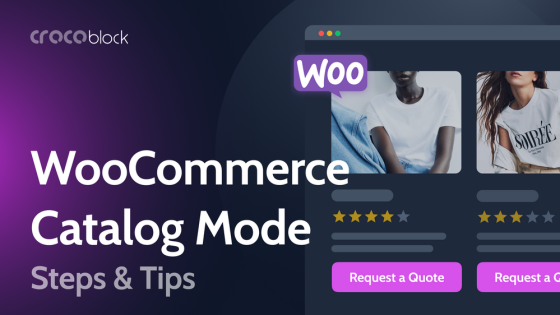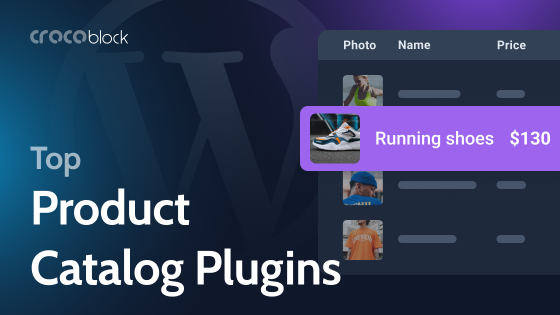The WooCommerce plugin for WordPress has a lot of space for modification, so, except for the traditional eCommerce website with prices, purchasing functionality, the “Add to Cart” button, and product variations, there can be a website with only a catalog of products or services. It can be complete with detailed descriptions and stunning visuals, but the functionality goes beyond just displaying products.
This article will delve into the benefits of using WooCommerce in catalog mode, explore its key features, and provide inspiring examples to get you started.
Table of Contents
- WooCommerce Catalog Mode Explained
- Key Features Catalog Websites Have
- 3 Inspiring Examples of Catalog Websites
- Enabling WooCommerce Catalog Mode
- FAQ
- Bottom Line
WooCommerce Catalog Mode Explained
In simple terms, a catalog website is a website that resembles a regular online store but without a purchase functionality: an “Add to Cart” button, cart, and checkout process. However, there you can find a list of products with descriptions, images, technical information, and whatever is applicable to that group of goods or services.
By using online catalogs, customers can get all the information about products or services, but to purchase them, they have to make an extra step – either fill out a form to inquire about the price or find a local retailer from the list to order what they want.
Catalog websites are not a simplified version of regular eCommerce websites; they have another purpose, and in some cases, this is the only possible option to showcase the products and provide full information about them. The next section will give you more ideas about the use cases for online catalog websites. One more thing I would like to mention is that such websites can be successfully created on WordPress using the WooCommerce plugin and a bit of tweaking.
Use cases for online catalog websites
Let’s start with the most frequent and popular use cases and continue with less obvious ones that might give some inspiration for your business.
International manufacturer’s product catalog
Manufacturers that sell their products worldwide, especially if they’re big companies with a lot of goods, usually don’t handle sales by themselves. Instead, a network of dealers, retailers, or both can be responsible for selling the products in their countries. Taxes, policies, shipping costs, and other more specific details vary depending on the country or even a region. This leads to changes in pricing, so it’s not possible to show fixed prices on the manufacturer’s website.
However, it’s important for the manufacturer to provide complete information about the goods so that both distributors and end users can find it easily. In addition to these details, such websites play a crucial marketing role in supporting the brand’s reputation.
B2B businesses with complex sales processes
This case is pretty similar to the previous one, but here, we talk about B2B in particular. Even if the manufacturer or a distributor is local and doesn’t have to handle different taxation and delivery options, they deal with wholesale pricing, and catalog mode is perfect for B2B businesses with tiered pricing structures. The company can showcase the product range, highlight features relevant to bulk purchases, and include a contact form for requesting quotes or discussing wholesale options.
Also, if the company relies on distributors to sell products, a catalog website allows it to showcase its offerings to potential distributors while directing customers to authorized retailers for purchase.
Showcasing products requiring quotes or customization
Catalog mode is ideal for showcasing high-end or bespoke items like furniture, jewelry, or artwork where pricing might depend on customization or consultations. The catalog can display stunning visuals and detailed descriptions and include a “Request a Quote” button to initiate personalized sales conversations.
One more variation of such a use case is businesses selling complex technical products like industrial machinery or medical equipment. These products can be cataloged to provide detailed specifications and features. Usually, the product pages include downloadable brochures and a “Contact Us” form for inquiries.
Pre-launch buzz generation
Even if we are not talking about international manufacturers or B2B companies, catalog websites, particularly WooCommerce in catalog mode, can be very useful, even for small businesses. You can create excitement for upcoming product launches and showcase upcoming products with captivating visuals and teasers without enabling purchases yet. Build a lead-generating form to notify potential customers when the product becomes available.
Another variation here is a catalog for new businesses with limited inventory, so a catalog-mode website allows you to showcase your offerings and capture leads while you establish the operations.
Brand awareness for service-based businesses
For businesses offering services like consulting or design, a WooCommerce catalog website can showcase expertise through case studies and project portfolios. Moreover, you can go beyond just products and use the catalog website to establish brand authority by offering valuable educational content related to your industry. This positions you as a thought leader and attracts potential customers.
WooCommerce catalog mode advanced use cases
The functionality described above can be expanded for use in specific situations. Let’s go through some examples.
Role-based pricing and access
Dealers or retailers can see specific pricing and bulk order options depending on their user roles, which count in previous purchasing history, loyalty programs, special offers, and so on. At the same time, regular customers can see the standard catalog without these options.
Also, registered or VIP users can have exclusive access to certain products or categories with special pricing or early access.
All of these can be implemented on WordPress using the JetEngine plugin and its membership module. With its help, you can create custom user dashboards depending on the user roles, so they will not see a standard WordPress admin panel.
Region-based catalog and pricing
In many cases, product availability depends on the region, so some products can be hidden depending on the user’s location. Also, some elements of the product page might be hidden. It’s quite easy to implement using dynamic visibility for WordPress.
Key Features Catalog Websites Have
There is a list of key features specific to catalog websites, and all of them can be implemented using WooCommerce:
- disabled Cart and Checkout functionality;
- disabled “Add to Cart” button;
- no prices;
- a button to request a price instead.
It was a short list of the main features of the catalog website. But there are more of them to make such websites serve the purpose and be effective:
- custom layout for product pages to make them engaging;
- a lot of technical or additional information about products to stimulate customers request for a price;
- well-done galleries to showcase products or services;
- proper contact forms and contact information for any inquiries;
- filters to find any product easily;
- technical specs for hi-tech products.
3 Inspiring Examples of Catalog Websites
Let’s have a look at a few well-made catalog websites and their features to demonstrate the features mentioned above and their implementation.
Herman Miller, a furniture shop

This website showcases furniture for offices and clinics, and the job is done truly beautifully. First, you see a captivating hero video, then a detailed gallery and a short description. After that, it’s a custom layout made of images and text to showcase every little detail of the product. And finally, technical specs, drawings, downloadable materials, and, of course, a contact form.
It’s definitely a great reference for design inspiration, and if you want to implement such layouts into your WooCommerce site, use the JetWooBuilder plugin or the eCommerce set from Crocoblock.
Lumicor, a catalog of 3D tiles

This company produces 3D tiles and shows how these tiles can look in real life and make any interior better. What is interesting about this WooCommerce catalog site is the steps on product pages: first, you choose a shape, then a pattern, and, finally, the finish. There are a lot of product attributes, and they made it look easy and intuitive. It’s definitely a good reference for variable products.
ROL Group, furniture for workspaces

This company offers high-end electrical desks for workspaces and some additional accessories. The design is quite minimalistic, and it definitely matches the style of their furniture. In addition, you can easily find all the specs, get an idea of how the products look and feel, and find reps to order what you need.
Enabling WooCommerce Catalog Mode
By default, WooCommerce doesn’t have a “magic button” to turn a default eCommerce website with pricing and cart functionality into a catalog mode. This might sound like a drawback, but if we think about the details, it becomes obvious that catalogs can actually be very different. For example, many technical WooCommerce catalogs have a lot of downloadable drawings and specifications combined with captivating videos or animations, as well as illustrations, as you can see from the examples above.
You can turn your default WooCommerce website into a catalog using some custom code, hooks in particular, or use dedicated catalog plugins for WordPress.
FAQ
A catalog website is a type of eCommerce website that doesn’t have cart functionality and prices but showcases detailed information about products or services with a “Request a Quote” form.
You will need a WooCommerce plugin and some other additional ones to turn a default website into a catalog.
Bottom Line
Catalog websites are a must-have for some businesses, mostly B2B. They help to provide all the detailed information but lead customers to sales representatives instead of handling sales on the website.
Using proper instruments for WordPress, you can turn a default WooCommerce website into a captivating catalog that converts and actually boosts sales, even without the cart functionality. In this article, I covered the key features of such websites, their use cases, and the examples that, I hope, can inspire you.

